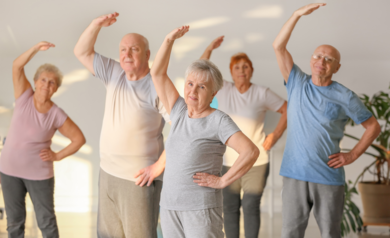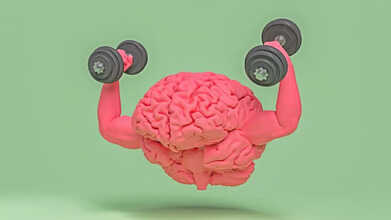- Health Conditions A-Z
- Health & Wellness
- Nutrition
- Fitness
- Health News
- Ayurveda
- Videos
- Medicine A-Z
- Parenting
- Web Stories
Skipping Weekday Workouts? This Diabetes Study Says Its Totally Fine Only 'If You Do This'

Credits: Canva
Can you really pack all your weekly exercise into the weekend and still get the benefits? If you have diabetes, the answer might surprise you. A new study published in the Annals of Internal Medicine reveals that people with diabetes who follow a "weekend warrior" workout routine squeezing all their recommended physical activity into one or two days have a significantly reduced risk of premature death. Specifically, they were 21% less likely to die from any cause and 33% less likely to die from heart disease, compared to those who don’t exercise at all.
The term "weekend warrior" refers to individuals who do not or cannot exercise daily but instead cram their full weekly dose of recommended activity into one or two sessions typically on weekends.
For adults, the general guideline is at least 150 minutes of moderate-intensity physical activity per week. That can include brisk walking, light cycling, yoga, dancing, or even heavy gardening.
And yes, that entire quota, according to this new study, can be done in just one or two days and still deliver significant health perks.
Researchers from Harvard T.H. Chan School of Public Health analyzed health and exercise data from nearly 52,000 adults with diabetes, collected between 1997 and 2018 through the U.S. CDC’s National Health Interview Survey. They then compared this with death certificate data from 2019 to draw their conclusions. Here’s what they discovered:
Diabetics who exercised one or two times per week and met the total 150-minute weekly target had a 21% lower risk of all-cause mortality than non-exercisers.
Their risk of death from heart disease was 33% lower.
Even those who exercised more frequently — in three or more sessions a week — saw a 17% reduced overall death risk and 19% less risk of dying from heart disease but the most unexpected insight? Weekend warriors may actually have a slight edge over regular exercisers when it comes to reducing heart-related mortality.
Why Its Important for People With Diabetes to Workout?
If you’re living with diabetes, physical activity isn’t just about burning calories or building muscle. It has a direct impact on blood sugar control, insulin sensitivity, and long-term cardiovascular health.
- Lowers blood glucose levels during and after activity
- Improves insulin sensitivity, which helps your body use insulin more efficiently
- Reduces HbA1c levels, even without weight loss
- Helps lower LDL (bad) cholesterol and raise HDL (good) cholesterol
- Improves mental health, reduces stress, and boosts energy
In short, movement is medicine especially for people managing a chronic condition like diabetes.
When and How to Work Out With Diabetes?
For people using insulin, the timing of workouts matters. The best time to exercise is typically 1 to 3 hours after a meal, when blood sugar levels are higher. If your blood glucose is under 100 mg/dL before a workout, eat a small snack or piece of fruit first to avoid hypoglycemia. Check your blood sugar before and after workouts — especially intense ones.
Be prepared, carry glucose tablets or candy, and wear a medical alert bracelet.
And remember, the goal isn’t perfection, it’s consistency. Whether it’s dancing, hiking, lifting weights, or long weekend walks, movement in any form helps.
What this study ultimately confirms is that flexibility matters. You don’t need to work out daily to gain life-saving benefits especially if weekday schedules make that hard.
Even if your job, caregiving duties, or chronic fatigue prevent you from regular weekday workouts, you still have a powerful tool in your hands. Just 2 to 2.5 hours of physical activity spread over Saturday and Sunday can significantly lower your risk of death and improve how your body handles diabetes.
It’s important to note: this study was observational, meaning it can’t prove cause and effect only association.
The researchers call for more comprehensive studies that track physical activity across entire days, including movement at work or during commutes. Still, this study adds to the growing body of evidence that any movement is better than none, and how you structure it can still produce powerful benefits.
If you’ve been feeling guilty about not being able to hit the gym every day, this research offers a hopeful message: even weekend workouts count, and in some cases, may be just as good or better. So the next time your weekend opens up, lace up those shoes, roll out your yoga mat, or head to the trail. Your body and your heart will thank you.
Fitness Coach Reveals 7 'Cheat Codes' That Help You Burn More Calories While Walking

(Credit- Canva)
What is an exercise that not only needs minimal equipment, but is also the most accessible for everyone, no matter how young or old they are? It is walking. Not just by fitness coaches, but also healthcare professionals, walking is regarded as one of the best ways to stay fit and healthy.
If you are looking to lose weight, but are worried about committing to a gym membership that you may not be able to finish, then you do not need to worry about elaborate home workouts, all you need is a pair of shoes and time to take a powerful stroll. But did you know, you could maximize this time and make your walking more efficient? Not only will this allow you to make the most of your time, but it will also help you lose weight easier?
According to fitness coach Dan Go, you can make your walks far more effective. He's developed a set of simple "cheat codes" that can help you burn more fat, significantly boost your energy levels, and even add years to your life. It's often seen as a simple, low-impact activity, that is easy to adjust to your levels of fitness. These small adjustments to your walking routine can lead to truly massive results.
7 Walking Tricks To Help You Lose Weight
Japanese Interval Walking
Forget boring, steady walks. This method involves a powerful rhythm: walk fast for three minutes, then slow for three minutes. Repeat this for 30 minutes. This style of walking is scientifically proven to burn more fat and significantly boost your fitness more effectively than a constant pace.
Walk on an Incline
Adding an incline to your walk, either on a treadmill or a hill, dramatically increases your calorie burn. A 5% incline can boost your burn by 50%, and a 10% incline can double it. It’s also gentler on your joints and works your glutes and hips more.
Walk After Meals
Just a short 2-5 minute walk after eating can make a huge difference. This simple habit helps lower blood sugar spikes by about 30%, which means you'll have fewer cravings, steadier energy, and your body will be less likely to store fat.
Try a Fasted Morning Walk
Walk before you have breakfast. When you walk on an empty stomach, your body is more likely to use stored fat for energy. Doing this outside also helps set your natural body clock and gives you a refreshing boost to start your day.
Walk While You Work
For those with a busy schedule, a treadmill desk is a fantastic solution. You can get in thousands of steps while you're at your standing desk. This lets you multitask and be active during meetings or while you're working on tasks.
Pyramid Walking Intervals
This method is a great way to improve endurance and burn fat. Start with an easy 5-minute warm-up, then gradually increase your speed and incline every 10 minutes. Finish with a four-minute push at your toughest pace before a cooldown.
Rucking
Turn your walk into a full-body workout by wearing a backpack with 5-10% of your body weight. This simple addition helps you burn more calories, while also strengthening your legs, core, and bones simultaneously for a more challenging and effective walk.
Can Leg Workouts Help Protect Your Brain From Ageing? Expert Weighs In

Credits: Canva
If staying sharp as you grow older is the goal, skipping leg day may not be the best idea. New findings suggest that your brain could benefit just as much as your body from squats and lunges.
A long-term study, first published in Gerontology by Karger Publishers, tracked older female twins for ten years to explore the link between leg strength and cognitive health. The results were clear: participants with stronger legs at the beginning of the study experienced far slower cognitive decline than those with weaker leg muscles.
To understand this connection better, we spoke with Dr. Indramani Upadhyay, MPT (Ortho), HOD – The Center for Knee & Hip Care, Vaishali, Ghaziabad, who shared his insights on the subject.
The Leg–Brain Connection
When we think about keeping the mind sharp, the usual suggestions include solving puzzles, reading, or practicing meditation. Yet growing research shows that one of the strongest ways to support brain health actually starts with the legs. As per Dr Upadhyay, strong leg muscles do more than keep us steady, they play a vital role in protecting memory, learning, and overall cognitive function.
Because the leg muscles are the largest in the body, every time they are put to work they send powerful signals that influence brain chemistry, circulation, and even the growth of new cells. Studies highlight several key benefits:
- Better blood flow: Leg-focused exercises improve circulation, delivering oxygen and nutrients the brain relies on.
- Myokine release: Contracting muscles release proteins known as myokines, which travel through the bloodstream and support nerve health and brain adaptability.
- Neurogenesis boost: Weight-bearing moves like squats and lunges may encourage the growth of new neurons in the hippocampus, the region responsible for memory and learning.
- Stress balance: Physical activity in the legs helps regulate hormones, easing inflammation and reducing stress—two major factors linked to cognitive decline.
Which Leg Exercises Boost Brain Health?
Dr Indramani explains that keeping your legs active does far more than build strength or tone muscles, it also supports brain health. Here are some of the most effective exercises:
1. Strength Training (Squats, Lunges, Step-Ups)
Movements that use your body weight or added resistance work the largest muscle groups in the legs. These exercises not only build muscle and protect bone health, but they also trigger the release of growth factors that sharpen memory and learning.
2. Walking and Jogging
Brisk walking or light jogging are simple yet powerful ways to improve cardiovascular fitness. Better circulation means more oxygen-rich blood reaches the brain. Walking outdoors adds even more value by lowering stress and boosting focus.
3. Cycling
Whether on a road bike or a stationary one, pedaling engages the legs continuously, keeping endurance and blood flow steady. Research links cycling to better reaction times, sharper executive function, and a lower risk of age-related cognitive decline.
ALSO READ: Ebola Outbreak: Why African Countries Are Disproportionately Impacted By The Disease?
4. Yoga Poses (Tree, Chair, Warrior Stances)
Balance-focused yoga postures recruit the legs while also improving flexibility and coordination. This mindful movement helps ease anxiety, sharpen concentration, and strengthen the mind-body connection.
Putting It All Together
The most effective routine is a balanced one: strength training two to three times a week, daily walking or cycling, and yoga for flexibility and balance. Together, they create a foundation that protects both body and brain.
Your legs are more than just a means of movement. They are engines that power your mental resilience. Keeping them strong is an investment not only in mobility but also in memory, focus, and long-term brain health.
Exercising Can Shrink Cancer Cells: Study Reveals Which Sport Protects You the Most

(Credit- Canva)
Cancer affects millions of people worldwide. No matter how careful you are or how healthily you live, cancer may catch you with you sooner or later. Breast cancer is the one of the leading causes of death in women and it was estimated to have caused 670,000 deaths globally and it also the most unpredictable. While there has been research done on it, according to the World Health Organization, half of the breast cancer occurs in women with no specific risk factor other than sex and age.
However, rehabilitation is also very possible, and many people have beaten the odds by surviving breast cancer. When someone goes into cancer remission, they are given some specific treatments so that the cancer does not come back. However, many times it is not as effective.
To find out better ways to keep cancer away, researchers looked into exercising, and focused one fitness program that could prove useful.
The August 2025 study, published in Breast Cancer Research and Treatment journal, suggests that exercising may directly help suppress the growth of breast cancer cells. The research involved 32 women who'd survived breast cancer and found that a single session of high-intensity interval training (HIIT) or weightlifting changed their body's chemistry.
Afterward, their blood contained higher levels of certain molecules that helped put the brakes on laboratory-grown breast cancer cells. This research adds to growing evidence that exercise is a powerful tool for cancer survivors.
How Exercise Works Against Cancer
For years, doctors have known that cancer survivors who exercise are less likely to have their cancer return. This new study helps explain why. When we use our muscles, they release special hormones and biochemicals called myokines into our bloodstream. These myokines are believed to be the body’s natural cancer fighters. In the study, blood taken from the women after they exercised was added to live cancer cells in a lab. The results were clear: the blood from both groups reduced cancer cell growth by 19% to 29%.
What Kind of Exercise is Best For Breast Cancer?
The study compared two types of workouts: HIIT and weightlifting. Both helped, but the blood from the women who did HIIT had a greater effect on the cancer cells, reducing their growth more significantly. This suggests that more strenuous, high-intensity workouts may be more effective at releasing the beneficial myokines, especially a key protein called IL-6. The study found that IL-6 levels were significantly higher in the HIIT group immediately after their workout.
This research has major implications for how we view exercise. It’s no longer just a "nice thing to do" to feel better; it's increasingly being recognized as a powerful tool in cancer treatment. The study's authors believe exercise could be a "first-line treatment" in its own right, alongside traditional therapies like chemotherapy and radiation. If you are a cancer survivor, you should talk to your oncologist before starting a new workout routine, but this study offers a hopeful message that working out can be a simple, accessible, and effective way to improve your health and cut the risk of cancer returning.
© 2024 Bennett, Coleman & Company Limited

